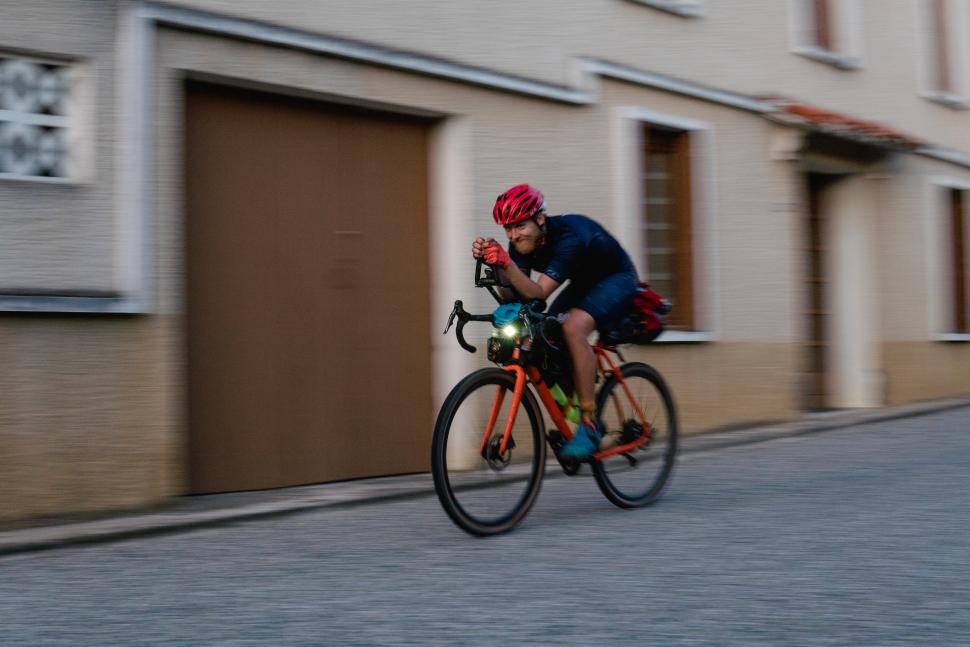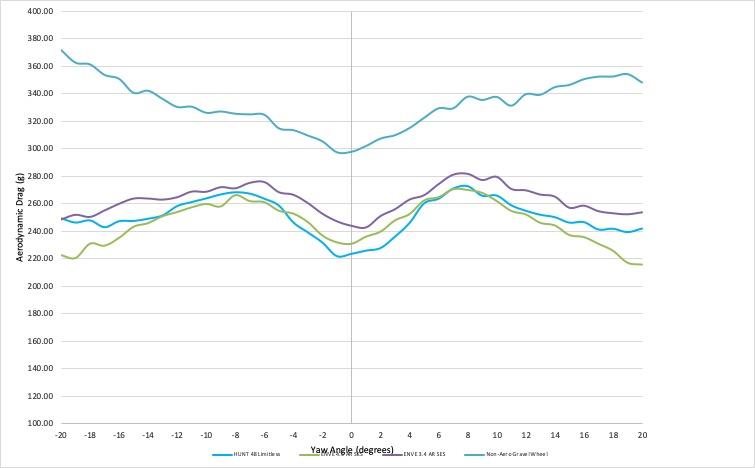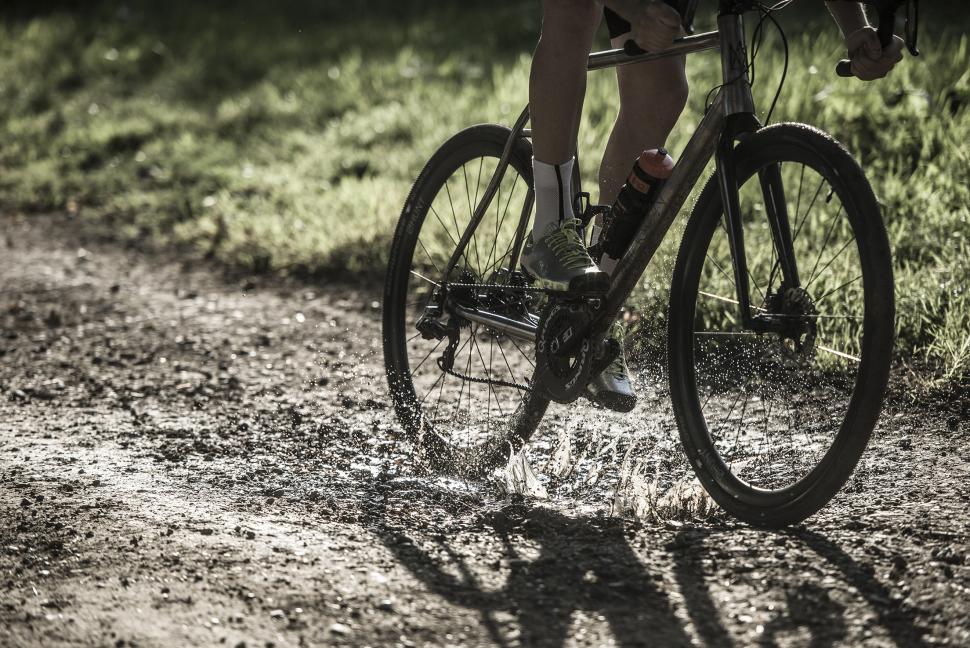- News
- Reviews
- Bikes
- Components
- Bar tape & grips
- Bottom brackets
- Brake & gear cables
- Brake & STI levers
- Brake pads & spares
- Brakes
- Cassettes & freewheels
- Chains
- Chainsets & chainrings
- Derailleurs - front
- Derailleurs - rear
- Forks
- Gear levers & shifters
- Groupsets
- Handlebars & extensions
- Headsets
- Hubs
- Inner tubes
- Pedals
- Quick releases & skewers
- Saddles
- Seatposts
- Stems
- Wheels
- Tyres
- Tubeless valves
- Accessories
- Accessories - misc
- Computer mounts
- Bags
- Bar ends
- Bike bags & cases
- Bottle cages
- Bottles
- Cameras
- Car racks
- Child seats
- Computers
- Glasses
- GPS units
- Helmets
- Lights - front
- Lights - rear
- Lights - sets
- Locks
- Mirrors
- Mudguards
- Racks
- Pumps & CO2 inflators
- Puncture kits
- Reflectives
- Smart watches
- Stands and racks
- Trailers
- Clothing
- Health, fitness and nutrition
- Tools and workshop
- Miscellaneous
- Buyers Guides
- Features
- Forum
- Recommends
- Podcast
TECH NEWS
 Hunt Gravel Wheels Testing Wheel
Hunt Gravel Wheels Testing WheelIs aero the next big thing in gravel? Hunt says so, and here's why
British wheels brand Hunt has been to the wind tunnel to find out whether aerodynamics makes a big difference to gravel riding performance, and found that it's a hugely important factor.
Hunt says that in the 200-mile Dirty Kanza, perhaps the world's most famous gravel event, using an aero-developed rim might save you more than six minutes over a standard rim.
Why is the question even being asked? You might have heard people say that typical speeds on gravel are too low for aerodynamics to matter much, or that turbulence created by large and knobbly tyre treads means that it's not worth focusing on.
On the other hand, the 3T Exploro, which Mat reviewed in 2016, was revolutionary for having aero performance as a key design feature. It has been used to win the Dirty Kanza.
Read our review of the 3T Exploro Pro GRX 2020
After numerous questions from customers and internal debates, Hunt headed to the GST wind tunnel in Immenstaad, Germany where they developed their Aerodynamicist wheel range, to find out for sure.
Aero is a bit of a hot topic in the world of gravel right now with many racers dividing opinion by using aero clip-on bars. A section of the gravel crowd sees aero as a ‘vibe’ killer, but that hasn’t stopped Hunt from find out how much aero matters on the unpaved dirt roads.
Hunt launches Carbon Aerodynamicist rim brake wheel range
Put simply, Hunt says that yes, aero matters for gravel. If you’re not interested in the science below then at least you have an answer. Want to know more? Well, here’s what Hunt says their paper looks into…
“This research white paper will discuss the testing and results that Hunt has yielded in understanding how the rim profile (depth, width), and gravel tyre options, (tread, width) affect the aerodynamics when considering the specific conditions appropriate to gravel racing seen at an event like Dirty Kanza. It will present how and why aerodynamic performance is an extremely important factor in the conditions and quantify those performance benefits of an aerodynamically designed rim compared to a normal rim designed without aerodynamics in mind.”
Check out our Hunt 4 Season Gravel Disc X-Wide Wheelset review
The brief
- Test two (leading) aerodynamically developed gravel rims from Enve, one non-aero optimised Hunt wheel (4 Season Gravel X-Wide) as well as their 48 Limitless Aero Disc.
- Conduct the test using the Schwalbe G-One 38mm tyre – a popular gravel tyre.
- A simulated moving speed of 32km/h – chosen to represent the speeds achievable in the Dirty Kanza 200-mile race (and also many others).
Considering tyres
During their research for the Limitless wheels, Hunt found that in order to achieve optimal aerodynamic performance across a range of yaw angles, that the rim profile should be very wide with a truncated edge (blunted spoke bed) to help airflow stay attached. This assumed that there wouldn’t be a large obstacle in the way of the airflow but as anyone running gravel tyres will know, a gravel tyre is quite a bit wider than the rim. So Hunt assumed that this, along with the added knob height of a gravel tyre, would cause early separation of the flow from the rim. That’s not good for aero performance.
At the wind tunnel, Hunt tested only the front wheels in order to remove as many variables as possible.
“The front wheels were set up using the specific single wheel rig, having been fitted with the same Schwalbe G-One 38mm tyre. Before each run, tyres were inflated to 100psi and aligned in the wind tunnel.”
100psi is a lot more than you'd run in a tyre of this type, but chose this pressure in order to ensure consistency in terms of the tyre's profile across the runs.
“For each run, the wheel was driven by the rollers at 32 km/h (20mph) and air was passed through the tunnel at a constant matching speed. The turntable was then rotated continuously through yaw angles between -20° and +20° to the oncoming airflow.”
The 32 km/h (20mph) speed was chosen because Colin Strickland’s 2019 Dirty Kanza success came at an average of 20.19mph.
Results
Hunt Limitless 48 - Bottom Blue Line | Enve 4.5 - Green Line | Enve 3.4 - Purple Line | Non-aero gravel wheel - Top Blue Line
Right then, on with the important bit: the results. What does it show? The headline is that in terms of aerodynamics only (not including any other forces) the non-aero Hunt gravel wheel was a whopping 9 watts slower than the fastest wheel, the Enve 4.5 AR SES. In terms of time gained over the course of the 200-mile Dirty Kanza, that’s six whole minutes.
Hunt’s own Limitless 48 wheel lost just 4.11 seconds to the Enve wheels over the theoretical 200 miles. In power terms, that’s just 0.09 watts.
Enve embraces disc brakes with new SES 4.5 AR Disc Carbon road wheelset
"Looking more closely at the drag curves, the three aero optimised wheels generally exhibit a reduction in drag at yaw angles after ± 8 degrees, whereas the non-aero optimised wheel does not and in fact trends up in increasing drag, another factor in the performance gap," says Hunt.
Conclusions
So, according to Hunt's data, aerodynamics matters greatly on gravel.
And that's not all. Hunt suggests that "if considerations are made to optimise a rim to a gravel tyre, then the gains could be reasonably significant".
Could Hunt be about to concentrate its efforts on aero rims that are optimised for gravel-tyres, then? We'll have to wait and see.
This might be concerning if you’re all about the laid back gravel vibe because, just think, the aero might not stop here. Heaven forbid, we could be heading towards speedsuits in gravel racing!
Latest Comments
- Martin1857 8 min 45 sec ago
As a member of the Co-op community (I live in a Housing Co-op) and a bike owner /rider, this is very sad news. We need more Co-ops not less.
- AnotherChrisOnAnotherTrike 9 min 36 sec ago
My EV exceeds the size. It's the smallest vehicle available which can transport my wife's trike (excursions or rescue).
- Dnnnnnn 0 sec ago
It is sad for the individuals concerned but (and this is a general point, rather than specific to this story), we're much better off overall for...
- No Reply 50 min 35 sec ago
I agree with Pogacar regarding social media. The likes of Facebook, Instagram have done untold damage, especially to the minds of young people....
- David9694 55 min 25 sec ago
Lorry carrying 25 tonnes of beer catches fire on the M11...
- No Reply 59 min 57 sec ago
If you're a cyclist on a road you are public enemy number 1.
- Rendel Harris 1 hour 29 min ago
He advocates only riding mountainbikes solely offroad for ultimate safety, which is great if you're a millionaire of leisure living in Colorado...
- ktache 2 hours 23 sec ago
That looks like a fun bike. Frame only, 2 and an 1/2 grand.
- wtjs 2 hours 56 min ago
Fair enough, personal experience may trump (not that one) theory. However, the bonking I have experienced has been due to lack of carbs. Your point...
- Rendel Harris 4 hours 24 min ago
mdavidfrodo?





Add new comment
13 comments
This really needs a flag, it's advertorial.
I guess more choice is never a bad thing but objectively speaking I fail to see how anyone except maybe a top competitive rider could reap any benefit. Come on, 32 km/h average on gravel.... Measured in a wind tunnel with a tire inflated to 6.9 bar that would yield 6 minutes over 200 miles. Right.
More wank marketing. Was looking at Hunt but Ive become allergic to bulls*&^t marketing recently. Would love to see the % of their target market who can average 20mph on gravel. Aspirational selling is the same as size ) models for womens clothing. Sell and market to REAL bikers. Aero gravel isnt the cutting edge of tech, It is wank
Can't get on board with that argument. Aero gains always useful on the road to cycle to/from the gravel paths in my neighbourhood.
Agreed, I took the gravel bike out yesterday as my road bike is on the turbo, I don't have aero wheels on it, but on the road and very smooth paths I wasn't far off the usual road bike speeds. And on the rougher gravel and grass etc I was up near 30km average. No I wouldn't be able to keep up that speed for 200km, nor do I want to attempt to, but if I was in the market for these kind of events, especially looking to try to win then I'd be interested in Aero gains.
It's not wank marketing on behalf of Hunt, in fact they're more open and honest about their aero testing than most wheel brands, which is refreshing. The argument that most of their target market couldn't average those speeds is a little pointless, as has been shown with road testing, slower riders may not gain the peak energy savings, but they do so for a longer period of time so the benefits can still be felt. They don't force you to buy into it, and it's not like they only make aero products. Cheer up and get outside for a bit!
If you don't care about being faster, why do you care? Some people ride gravel on a fatbike. Good for them.
Most people that I see though, are trying to optimize their bike to be as fast as possible. If that is the case, looking at aero wheels is just as reasonable for gravel as it is for triathlon riding.
The question to ask is:
What is the 'cost' of using a more aero solution?
The cost can be financial, weight, rolling resistance, comfort or lack of control.
You need to weigh all those factors for your personal situation to determine your best option. But to dismiss aero wheels for gravel out of hand is silly.
For some examples:
A tight, fitting 'aero' jersey:
-Fair aero benefits, and assuming that you have to wear a jersey anyway, essentially zero cost in money, weight or comfort. Easy choice.
Aero bars:
-small cost in money, moderate cost in weight, significant lack of control when using. But, large aero gains, large comfort gains, and you don't have to use them all the time. Toss up for many people.
23mm time trial tires on disc wheels:
-Large aero gains, but high rolling resistance, lack of control, uncomfortable and likely to flat. Nobody chooses these for gravel.
In this way, if you are building a gravel bike, you need to choose what wheels you put on it. One or more aero wheels, might be a worthwhile option. The question to ask is what the 'cost' is.
For example, if you look at Enve, the price is (about) the same, and the 4.5 is about 150g heavier than 'regular' gravel rim.
So even thought he time savings might not be huge from the aero benefit, the 150g probably isn't causing a huge slow down either.
Personably, for gravel it seems unlikely that a rear wheel would ever see a noticeable benefit from an aero rim, but in the front it likely is a net gain in speed.
Its a shame the average gap between riders on the Kanza tends to greater than 6 minutes. 8-10 from a quick review of the past results. You have to go back to 2016 where it would have definately made a difference.
Also that average speed is taken from the winner. Everyone else had a slower average than 20mph - therefore even less gains.
It's a shame the race doesn't take place in a wind tunnel, as outside of a velodrome the air is almost never stationary, and then isn't laminar, so the results aren't worth much beoynd aero is important to some extent.
Most people at the sharp end are likely to be running aero wheels already so the gains wouldn't be as significant as compared to the non-aero wheel they used as a baseline. And I would not describe 9 watts between best and worst as "whopping".
One crucial difference is between the price of Hunt 48s and Enve rims.
Interesting that these aero rims get better at wider yaw while the baseline gets worse. The 3 designs seem to have very similar characteristics. Due to the surfaces encountered rollling resistance will be a more significant factor so for me tyre choice and pressure would be rather more crucial than wheels.
It's counterintuitive, but the slower you are, the greater the gains from aero. Why? What? Because a slower rider puts out fewer watts, gains from aero (or rolling resistance) are relatively much more significant, and result in much greater time gains than for a fast rider with lots of watts. For any speed above 15kph, aero losses are greater than all the others pot together, so aero matters for all riders, especially those who are out on the course for the longest.
Just because 6 minutes doesn't necessarily move you up a spot in the ranking, doesn't mean it's not something a competitor wouldn't choose to use.
And as mentioned, slower riders spend a longer time on course, so even though their absolute power savings are smaller, their time savings are often similar.
Then there is the fact that slower riders experience a higher range of effective yaw angles than faster riders, so are spending more time in the higher yaw angles where benefits are greatest.
Think the only "significant gains" here will be for hunt, from washed up roadies wallets.
Absolutely. And most people going 20mph on gravel quite likely have wheel sponsors I'd imagine. Some fools will fall for it.